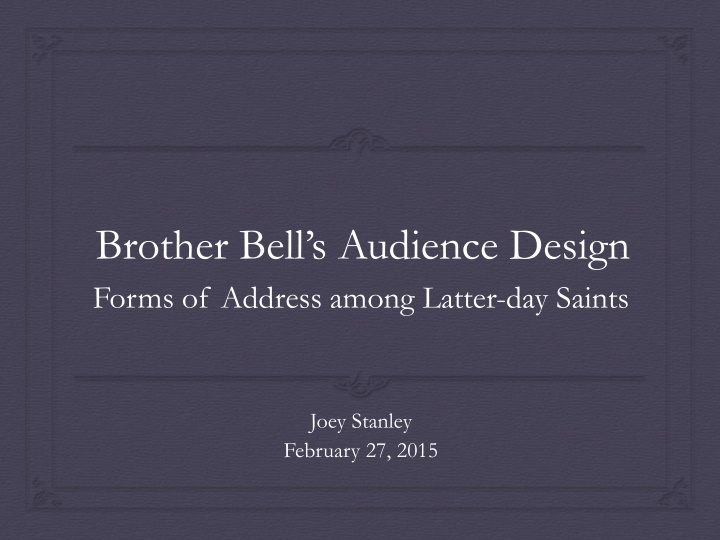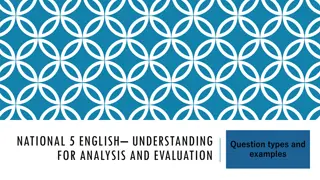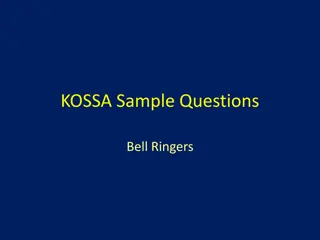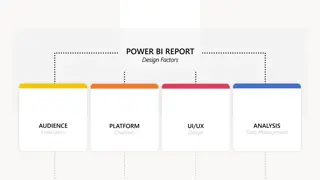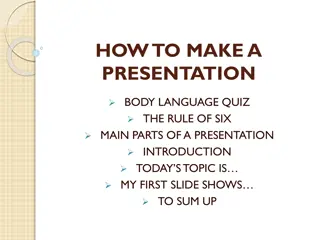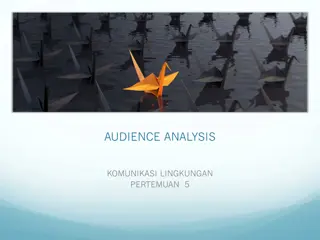Brother Bell’s Audience Design
Sociolinguistics explores the systematic variation in language use, focusing on the T-V distinction and forms of address in English, especially in communities where titles like First Name (FN) + Last Name (TLN) are prevalent. This study delves into the factors influencing forms of address in LDS communities, examining literature reviews, methodologies, results, discussions, conclusions, and potential future research directions. The analysis touches on power dynamics, intimacy, status, and societal norms that shape communication patterns within these communities.
Download Presentation

Please find below an Image/Link to download the presentation.
The content on the website is provided AS IS for your information and personal use only. It may not be sold, licensed, or shared on other websites without obtaining consent from the author.If you encounter any issues during the download, it is possible that the publisher has removed the file from their server.
You are allowed to download the files provided on this website for personal or commercial use, subject to the condition that they are used lawfully. All files are the property of their respective owners.
The content on the website is provided AS IS for your information and personal use only. It may not be sold, licensed, or shared on other websites without obtaining consent from the author.
E N D
Presentation Transcript
Brother Bells Audience Design Forms of Address among Latter-day Saints Joey Stanley February 27, 2015
Introduction Language varies Sociolinguistics tries to explain that variation is systematic T-V distinction English Forms of Address First Name (FN) or Title + Last Name (TLN) Only exists in communities where potentially everyone has a title Teachers, military, doctors, politicians, police, etc. Slowly on the decline everywhere else in the US Goal: Show that forms of address in LDS communities are determined by many factors Outline: Literature review, methodology, results, discussion, conclusion, future work
Literature Review Power, solidarity, intimacy, status, etc. determine T-V forms (Brown & Gilman 1960, Brown & Ford 1961, Slobin et al 1968 ) Titles aren t used as much in the general population. (Murray 2002) Female professors received more FN. Female students used more FN with professors. (Rubin 1981; Takiff, Sanchez & Stewart 2001) Hillary Clinton often called FN in the media. (Uscinski & Goren 2010) Different talking to or talking about people (Dickey 1997) Lots of messy things with newlyweds and in-laws (Jorgenson 1994)
Social Dyads (Brown & Ford 1961) Non-reciprocal relationship One person receives TLN, the other receives FN Employer-employee Age difference Adult-child +15 years for adults Service occupations (butlers, waiters, etc.) Teacher-student Reciprocal Relationship ( T ) Mutual FN Friends, equals, colleagues, etc. Reciprocal Relationship ( V ) Mutual TLN People with potentially equal status, but who don t know each other well
Transition Phase It seems likely that the two reciprocal patterns are on a dimension that ranges from acquaintance to intimacy. However, in modern American English the distance between the two points is small with the Mutual FN usually representing only a very small increment of intimacy over the Mutual TLN; as small sometimes as 5 minutes of conversation. Because the segment of the line that lies between the two patterns is usually so very short, it is not easy to make out its exact character. Brown & Ford (1961:377) (emphasis added)
Research Questions What factors influence forms of address between two people who are of roughly equal status?
Why Latter-day Saints? Brother or Sister + last name. Cultural norms Strong and active but largely below the radar Interaction with general tendency of FN with familiarity Ward organization and composition Congregations (aka wards ) have strict delineated boundaries People only share one feature: where they live Roughly 100 150 people Interaction with anyone from strangers to close friends/family on a weekly basis Address forms go from mutual TLN to mutual FN over the course of months or years
Address forms among Mormons (Fogg 1990) Observed 6 congregations in Utah No observer s effect, but no metadata Did not include 3rd person reference terms and dismisses them as irrelevant Marked 3 levels of formality: over the pulpit, Sunday school, and casual more formal = more TLN His strongest predictor. Status determined by >15 year age difference (Brown & Ford 1961:377) More FN towards younger people Gender of speaker and addressee A hint of more FN between women
Target Population 21 married couples from the Athens 1st Ward White, heterosexual Ages 20 36 (mean=28); therefore all the same status From high school education to Ph.D. Roughly half are from Georgians and half are transplants. Minimum of 7 years in the church, though most were raised Mormon. Roughly 1/3 of the congregation No singles were included Divorcees or otherwise unmarried individuals Most attend another congregation for single members Anecdotal evidence suggests marital status is an important factor and I didn t want my data spread too thin.
Survey How well do you know this person? O O O 26 Situation 1 Situation 2 Situation 3 Situation 4 ____________ Your Age (optional) First Bro/Sis Other First Bro/Sis Other First Bro/Sis Other First Bro/Sis Other Mitt Romney X X Ken Jennings X X Gladys Knight X X David Archuleta X X Glenn Beck X X 1 2 3 4 5 1 2 3 4 5 1 2 3 4 5 1 2 3 4 5 1 2 3 4 5 O X X X X FULL FULL O X X X X * Names have (obviously) been changed. 42 names down the side, 4 situations across the top Asks how well participant knows the person 31 participants returned the survey 5147 forms of address, 1270 relationship data points
Audience Design 4 Situations based on Audience Design (Bell 1984) Speakers design their style based on who they are talking to. Audience Design proposes that they also vary in who else is listening. Implicational hierarchy: variation with one presupposes variation with Types closer to the speaker. Speaker Addressee Auditor Overhearer Eavesdropper Adapted from Bell (1984:159)
auditor known ratified not addressed addressee known ratified addressed speaker eavesdropper not addressed not ratified unknown overhearer known not ratified not addressed
Why Audience Design? Not used much in studying Address Forms Fogg (1990) dismisses it by logical analysis Bell says it affects every aspect of language (Bell 2013)
The Four Situations (Exact descriptions of each refer to a lot of Mormon culture that would be tangential for the purposes of this presentation.) Four situations puts the other person in each of the four Audience Types Situation 1 (Addressee): Direct address Situation 2 (Auditor): Small committee meeting Situation 3 (Overhearer): Talking to spouse about them at church Situation 4 (Eavesdropper): Talking to spouse about them while driving home Situations 3 and 4 control for the addressee.
Independent Variables Familiarity Prediction: very significant. The closer the two, the more likely FN is used (Brown and Gilman 1960) 4 Situations Prediction: significant (Fogg 1990) Familiarity between spouse and 3rd person Prediction: significant. Accommodation to addressee s familiarity (Dickey 1997) Age difference Prediction: slightly significant. < 7 year age difference = more FN (Brown and Ford 1961) Sex Prediction: women use more FN (Fogg 1990). Parenthood Prediction: parenthood is seen as a higher status
Analysis Some quantitative Rbrul Shows which factors are significant Mostly qualitative Observation of graphs created in Excel Significance often not clear
Results (Rbrul) Familiarity 5 4 3 2 1 Range FW 0.864 0.77 0.577 0.271 0.085 77.9 % 0.91 0.808 0.595 0.272 0.077 N 659 583 746 592 1964 Situation Addressee Eavesdropper Overhearer Auditor Range FW 0.61 0.54 0.521 0.334 27.6 % 0.453 0.426 0.412 0.319 N 1185 1079 1112 1168 Children Yes No Yes Yes Yes Yes No Yes Range Sexes Woman Woman Man Man Women Man Man Woman Range 0.535 0.519 0.519 0.427 10.8 0.327 0.494 0.472 0.319 1133 589 1742 1080 0.672 0.475 0.473 0.375 29.7 0.538 0.691 0.492 0.181 1105 1155 1118 1166 Spouse-3rd Person Relationship 5 4 3 2 1 Range 0.653 0.583 0.484 0.396 0.382 27.1 0.806 0.691 0.492 0.289 0.181 654 586 754 596 1954
100% Familiarity 90% 80% Clearly the most significant factor. However, the extremes are not categorical. Quite a level slope. 70% 60% %FN 50% 40% 30% 20% 10% 0% 1 2 3 4 5 Familiarity Hypothesized FN FN
100% Male/Female 90% 80% 70% Women use FN with other women more at all levels of familiarity. There s an unexpected leveling off for Man- to-Woman Level 5 relationships. 60% % FN 50% 40% 30% 20% 10% 0% 1 2 3 4 5 Familiarity Male Male Female Male Male Female Female Female
100% Spouse 3rd Person Relationship 90% 80% 70% The better the spouse knows a person, the more likely they will use FN. This may be a a function of how well the speaker knows the person since couples often hang out in pairs. Overlaid graph suggests some influence in both directions. % FN (by speaker) 60% 50% 40% 30% 20% 10% 0% 1 2 3 4 5 Spouse-3rd Person Relationship All Situations Situations 3 and 4 Only
100% Situation 75% Situations 1, 3, 4 generally the same. Situation 2 surprisingly showed less FN, even among close relation- ships. % FN 50% 25% 0% 1 2 3 4 5 Familiarity Addressee Overhearer Auditor Eavesdropper
100% Situation 90% 80% Women use more FN towards addressees. Men use less FN towards auditors. 70% 60% % FN 50% 40% 30% 20% 10% 0% Addressee Auditor Overhearer Eavesdropper Men Women
100% Children 90% 80% Children were statistically significant in predicting FN. However, this may be just a result of social networking. Parents are friends with parents; non- parents are friends with non-parents. 70% 60% % FN 50% 40% 30% 20% 10% Children Yes No Yes Yes Yes Yes No Yes Range 0% 0.535 0.519 0.519 0.427 10.8 0.327 0.494 0.472 0.319 1133 589 1742 1080 1 2 3 4 5 Familiarity NN NY YN YY
5 100% Age 4.5 90% 4 80% Average Realtionship FN is used more with people within a certain age range. Overlay average relationship however, and we see that this reflects social networks, not age. Conclusion: Age is not a significant predictor of address forms. 3.5 70% 3 60% % FN 2.5 50% 2 40% 1.5 30% 1 20% 0.5 10% 0 0% -13 -11 -9 -7 -5 -3 -1 1 3 5 7 9 11 13 Age Difference FN Average Relationship
Discussion/Summary Familiarity is easily the strongest factor Perhaps influences other factors as well People use FN more with others of the same sex, especially women. Camaraderie among LDS women (Fogg 1990) Speaker accommodates to Spouse 3rd Person relationship Men are influenced by the presence of an Auditor. Possibly because of more leadership meetings Parents and non-parents are considered slightly different. Age is not a factor, contrary to other studies
Audience Design 100% 90% 80% This research challenges the implicational hierarchy of Audience Design. If variation occurs with one Audience Type, it is expected to occur with Types closer to the speaker. Yet, for men, Auditors are different while Addressees are not affected. 70% 60% % FN 50% 40% 30% 20% 10% 0% Addressee Auditor Men Overhearer Eavesdropper Women
Conclusions Forms of Address between equals is determined by many factors: familiarity, audience, situation, gender, and parenthood Bell s Audience Design may be different for men and women. Parenthood may be considered a higher status. There exists a robust address form system, despite a general decline in the US.
Future Research Future Research: More congregations = more data + geographic trends Parenthood > Married > Unmarried Observed data instead of reported data More statistics More situations (other auditor situations, etc.) Does this spread to non-LDS communities? and
AS TS Social Network Analysis EB DC GA BH EC ML CW KC SL EM KW RW BW SJ RM LS CJ DJ LT SB SS BC DY SC TA AY LN DT JB AS AJ DA TS IY RN AP MJ JS JP BS RR EB DC GA BH LR EC ML CW KC SL EM KW RW BW SJ RM LS CJ DJ LT SB SS BC DY SC TA AY LN DT JB AJ DA IY RN AP MJ JS JP BS RR LR
References Bell, Allan. 1984. Language style as audience design. Language in Society 13(02). 145 204. Bell, Allan. 2013. The guidebook to sociolinguistics. John Wiley & Sons. Brown, Roger & Marguerite Ford. 1961. Address in American English. The Journal of Abnormal and Social Psychology 62(2). 375. Brown, Roger & Albert Gilman. 1960. The pronouns of power and solidarity. In T. A. Sebeok (ed.), Style in Language, 253 76. Cambridge: MIT Press. Dickey, Eleanor. 1997. Forms of address and terms of reference. Journal of Linguistics 33(2). 255 274. Jorgenson, Jane. 1994. Situated address and the social construction of in law relationships. Southern Communication Journal 59(3). 196 204. Labov, William. 1964. The social stratification of English in New York City. Columbia university. Murray, Thomas E. 2002. A new look at address in American English: The rules have changed. Names 50(1). 43 61. Rubin, Rebecca B. 1981. Ideal traits and terms of address for male and female college professors. Journal of Personality and Social Psychology 41(5). Takiff, Hilary A., Diana T. Sanchez & Tracie L. Stewart. 2001. What s in a name? The status implications of students terms of address for male and female professors. Psychology of Women Quarterly 25(2). 134 144. Uscinski, Joseph E. & Lily J. Goren. 2010. What s in a Name? Coverage of Senator Hillary Clinton during the 2008 Democratic Primary. Political Research Quarterly 64(4). 884 896.
